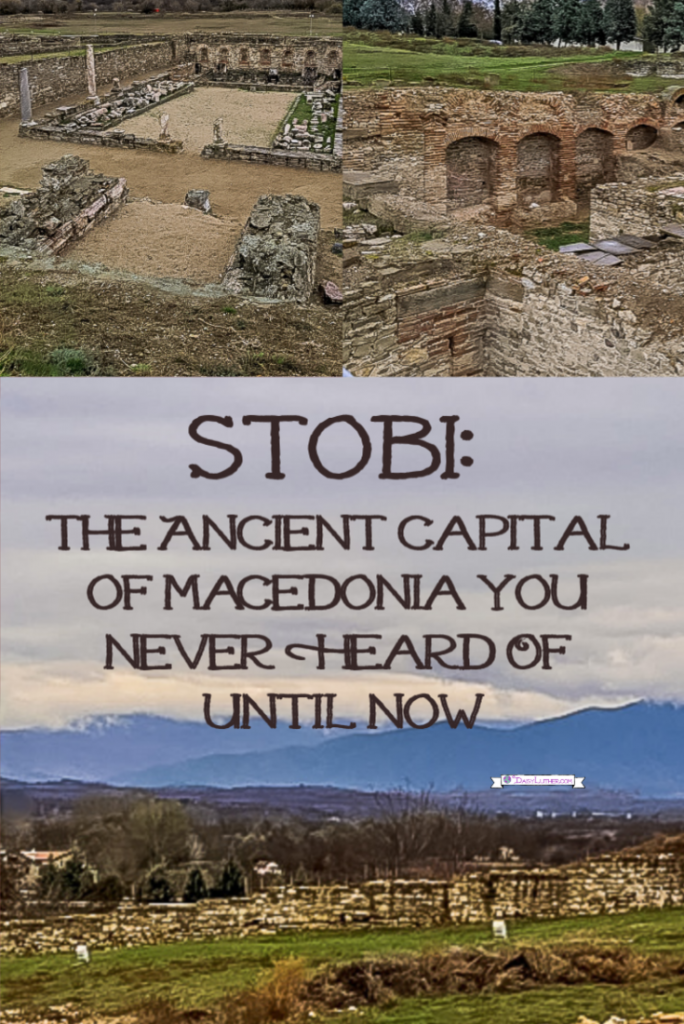Stobi: The Ancient Capital of Macedonia You Never Heard Of Until Now
When I hired a car and driver from a service called My Day Trip to take me from Thessaloniki, Greece to Skopje, North Macedonia, it was only $40 more to make two “tourists stops” along the route. Since I was already paying far less than I would have for a flight, I thought, “Why not?” and opted to go to two places I’d never heard of before: Stobi and Matka Canyon.
It was a cold day with spells of freezing rain mixed with snow. My driver, Demeter, spoke excellent English and was very friendly in a non-creepy way. After he helped me get my luggage into the trunk I decided to hop in the front so we could talk.
At this point, I was thinking to myself, “Do I really want to stop and wander around a tourist attraction in this weather?”
Thankfully, my self answered, “Damn right you do. Don’t be a sissy!”
The Ancient City of Stobi
Stobi is an ancient archaeological site near the village of Gradsko, North Macedonia, just off the A-1/E-75 highway. This is the highway you’ll take if you are driving between Thessaloniki and Skopje and is not at all out of the way.
I actually lucked out with the weather. I was the only person there exploring Stobi. I went into a little trailer to pay admission and Demeter, the driver, stayed in the car to read a book.
I’d never heard of Stobi before so I had to do some quick research to understand what I was seeing. Prepare yourself for nerdy archaeological and historical stuff.
I’m going to try and put these different ruins in historical order from oldest to most recent.
The oldest structure is the Temple of Isis. It most likely dates back to 200ish BC. That is suspected because that was when Philip V took control of Egypt. This site was only discovered in 2008 and is still being excavated (That’s what those big squares are – a grid excavation.) There are some random pieces recovered that were probably part of the sanctuary.
A Roman structure with lots of arches is from around the First Century AD. That’s when Macedonia became a Roman province after having been independent from them for a couple hundred years. There was also a Roman theater from the same era that was where people performed in plays and where gladiator games were held.
A Jewish temple was built here by Polycharmos from II to IV AD. A Christian church was built on the remnants of the synagogue between IV -VI AD. You can also see the remains of some kind of homes and palaces from the first few centuries AD. There is also a “Sacred Street” in the ancient settlement of Stobi dates back to 1 AD, which is filled with the ruins of old basilicas and Christian relics.
Amazingly, Stobi’s walls remain more than 2000 years later.
I loved how you could make a historical timeline in this little settlement, based on the different religions and customs. Here’s what “Exploring Macedonia” had to say about the origins of Stobi.
The old city of Stobi “…Stobis, vetus urbs…”, as the Roman historian Livy named it, at the confluence of rivers Crna and Vardar, was the largest city in the northern part of the Roman province Macedonia, later capital city of the Roman province Macedonia Secunda, an important urban, military, administrative, trade and religious center of two large empires: Roman and Early Byzantine. Located in the heart of Macedonia, on the crossroads between the Aegean World and the Central Balkan, during the whole period of its existence, it was a place where cultural achievements of the ancient world gathered in a unique way.
The town of Stobi was built in the Hellenic period, sometime before the rule of the Macedonian king Philip the Fifth. It was situated 160 km from Thessalonica on the main road Via Egnatia that led from the Danube to the Aegean Sea. Because of its location, Stobi was an important army, strategic, economic and cultural center at the time. Owing to the numerous historical and literary documents and archeological findings from thorough research done in the area, there is a complete urban picture of Ancient Stobi, its architectural structure and organization of life, which speaks of a highly developed urban society with a high level of cultural development. Considering these facts and according to some additional sources, the beginnings ofStobi were much earlier, in the 7th and 6th Century BC. Some bronze objects discovered here and dating from ancient times include ceramic findings, which point to life in it as early as the Neolith and the Iron Age. (source)
This was a totally unexpected sight-seeing treasure and well-worth braving the cold and the rain. Just as I finished poking around Stobi (I was there for about an hour) a tour bus stopped and dozens of travelers got out. Perfect timing!
Here are some of the photos I took of Stobi. You can find more here on my Instagram.
What you should know about Stobi
Here are the answers to the most commonly asked questions about visiting the archaeological site of Stobi.
How physically challenging is visiting Stobi?
You’ll probably walk about one mile if you explore the entire site. The paths are not paved but they’re fairly smooth. There are a couple of places with 3-4 steps. All in all, Stobi isn’t extremely physically challenging for those who are mobile.
What’s the bathroom sitch?
There is a bathroom right beside the trailer where you pay admission. BYOTP. (Bring your own toilet paper!)
Is there food?
There is no food or drinks sold at Stobi.
Is there anything tourists should be warned about at Stobi?
Stobi seems to be completely safe. There was a friendly dog that belonged to the young woman working in the trailer.
How expensive is Stobi?
Admission for adults is 120 Macedonian denars (2 Euros), and for children and seniors, is 50 denars (1 Euro). If you’re with a group of more than 10 people, admission is 100 denars (1 Euro and 70 cents.)
Are you going to Stobi?
Are you thinking of visiting Stobi? Let me know if you have any questions. If you’ve been, please share your experience in the comments.




